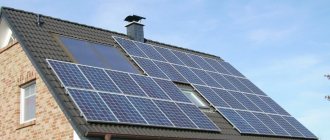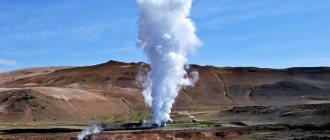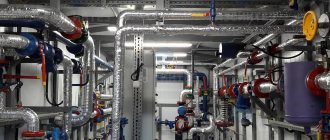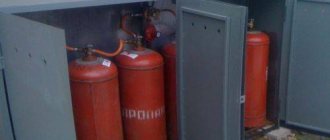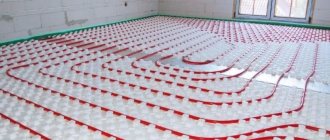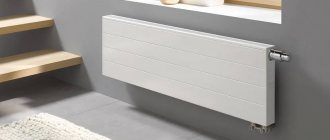Energy in physics
Kinetic and potential energy
Kinetic energy of a body of mass m
, moving with speed
v
is equal to the work done by the force to give the body speed
v
.
Work here is defined as a measure of the action of a force that moves a body a distance s
. In other words, it is the energy of a moving body. If the body is at rest, then the energy of such a body is called potential energy. This is the energy required to maintain the body in this state.
Sir Adam Beck Hydroelectric Power Station. Niagara Falls, Ontario, Canada.
For example, when a tennis ball hits a racket in flight, it stops for a moment. This happens because the forces of repulsion and gravity cause the ball to freeze in the air. At this moment the ball has potential energy, but no kinetic energy. When the ball bounces off the racket and flies away, it, on the contrary, acquires kinetic energy. A moving body has both potential and kinetic energy, and one type of energy is converted into another. If, for example, you throw a stone up, it will begin to slow down as it flies. As this slows down, kinetic energy is converted into potential energy. This transformation occurs until the supply of kinetic energy runs out. At this moment the stone will stop and the potential energy will reach its maximum value. After this, it will begin to fall down with acceleration, and the energy conversion will occur in the reverse order. The kinetic energy will reach its maximum when the stone collides with the Earth.
The law of conservation of energy states that the total energy in a closed system is conserved. The energy of the stone in the previous example changes from one form to another, and therefore, although the amount of potential and kinetic energy changes during the flight and fall, the total sum of these two energies remains constant.
What quantities are used in calculations
The simplest calculation of boiler power by area looks like this: you need to take 1 kW of power for every 10 sq. m. However, it is worth considering that these standards were drawn up during the Soviet Union. They do not take into account modern construction technologies; in addition, they may turn out to be untenable in areas whose climate is noticeably different from the conditions of Moscow and the Moscow region. Such calculations may be suitable for a small building with an insulated attic, low ceilings, excellent thermal insulation, double-glazed windows, etc. Unfortunately, only a few buildings meet these requirements. To make a more detailed calculation of the boiler power, you need to take into account a number of factors, such as:
- climatic conditions in the region;
- dimensions of the living space;
- degree of insulation of the house;
- possible heat loss of the building;
- the amount of heat required to heat water.
In addition, in houses with forced ventilation, the calculation of the heating boiler must take into account the amount of energy required to heat the air. As a rule, you need to use special software for calculations:
When calculating the power of a gas boiler, you should add about 20% more in case of unforeseen situations, such as severe cold or a decrease in gas pressure in the system.
Energy production
People have long learned to use energy to solve labor-intensive tasks with the help of technology. Potential and kinetic energy are used to do work, such as moving objects. For example, the energy of river water flow has long been used to produce flour in water mills. As more people use technology, such as cars and computers, in their daily lives, the need for energy increases. Today, most energy is generated from non-renewable sources. That is, energy is obtained from fuel extracted from the depths of the Earth, and it is quickly used, but not renewed with the same speed. Such fuels include, for example, coal, oil and uranium, which is used in nuclear power plants. In recent years, the governments of many countries, as well as many international organizations, such as the UN, have made it a priority to study the possibilities of obtaining renewable energy from inexhaustible sources using new technologies. Many scientific studies are aimed at obtaining such types of energy at the lowest cost. Currently, sources such as solar, wind and waves are used to generate renewable energy.
Energy for domestic and industrial use is usually converted into electricity using batteries and generators. The first power plants in history generated electricity by burning coal or using the energy of water in rivers. Later they learned to use oil, gas, sun and wind to generate energy. Some large enterprises maintain their power plants on site, but most of the energy is produced not where it will be used, but in the power plants. Therefore, the main task of energy engineers is to convert the energy produced into a form that allows the energy to be easily delivered to the consumer. This is especially important when expensive or hazardous energy production technologies are used that require constant supervision by specialists, such as hydro and nuclear power. That is why electricity was chosen for domestic and industrial use, since it is easy to transmit with low losses over long distances via power lines.
Transmission pylons near the Sir Adam Beck hydroelectric power station. Niagara Falls, Ontario, Canada.
Electricity is converted from mechanical, thermal and other types of energy. To do this, water, steam, heated gas or air drive turbines, which rotate generators, where mechanical energy is converted into electrical energy. Steam is produced by heating water using heat produced by nuclear reactions or by burning fossil fuels. Fossil fuels are extracted from the depths of the Earth. These are gas, oil, coal and other combustible materials formed underground. Since their quantity is limited, they are classified as non-renewable fuels. Renewable energy sources include solar, wind, biomass, ocean energy, and geothermal energy.
In remote areas where there are no power lines, or where economic or political problems regularly cause power outages, portable generators and solar panels are used. Generators running on fossil fuels are especially often used both in everyday life and in organizations where electricity is absolutely necessary, for example, in hospitals. Typically, generators operate on piston engines, in which fuel energy is converted into mechanical energy. Also popular are uninterruptible power supply devices with powerful batteries that charge when electricity is supplied and release energy during outages.
Florida Power and Light power plant. Port Everglade, Florida, USA. This power plant consists of four blocks and runs on gas and oil.
Energy produced by burning fossil fuels
Fossil fuels are formed in the earth's crust at high pressure and temperature from organic matter, that is, the remains of plants and animals. Basically, such fuel contains a large amount of carbon. When it burns, it releases energy as well as carbon dioxide (CO₂), one of the greenhouse gases. Fossil fuels are the main source of energy at the moment. However, the greenhouse gases released during its use pose a serious threat to the environment and aggravate global warming. Also, the use of this fuel leads to its rapid consumption, and humanity may be left without fuel if it is completely dependent only on fossil raw materials.
Nuclear power plant cooling towers. Photo from the archives of the site 123RF.com.
Atomic Energy
Nuclear energy is one of the alternative types of energy. It is released during a controlled nuclear fission reaction, during which the nucleus of an atom is divided into smaller parts. The energy released during this reaction heats the water and turns it into steam, which drives turbines.
Nuclear power is not safe. The most famous accidents in recent years occurred at the Chernobyl nuclear power plant (NPP) in Ukraine, at the Three Mile Island nuclear power plant in the United States, and at the Fukushima-1 nuclear power plant in Japan. After the Fukushima tragedy, many countries began to reconsider their domestic nuclear energy policies, and some, such as Germany, decided to abandon them. Germany is currently developing a program for the transition to other types of energy supply and the safe closure of existing power plants.
In addition to accidents, there is also the problem of storing spent nuclear fuel and radioactive waste. Some of the spent nuclear fuel is used in weapons production, medicine, and other industries. However, most radioactive waste cannot be used and therefore it is necessary to ensure its safe disposal. Each country that has nuclear power plants stores this waste differently, and many countries have laws prohibiting its import into the country. Radioactive waste is treated so that it does not enter the environment, does not decompose, and is convenient for storage, for example, by making it more compact. After this, they are sent for burial in long-term storage facilities at the bottom of seas and oceans, in geological structures, or in pools and special containers. Storage is associated with problems such as the high cost of processing and disposal, leakage of radioactive elements into the environment, lack of storage space, and the possibility of terrorist attacks at radioactive waste disposal sites.
Nuclear power plant in Pickering, Ontario, Canada
A much safer alternative is to produce nuclear energy through fusion. During this reaction, several nuclei collide at high speed and form a new atom. This happens because the forces that repel nuclei from each other are weaker at a short distance than the forces that attract them. A thermonuclear reaction also produces radioactive waste, but it ceases to be radioactive after about a hundred years, while the waste from a fission reaction does not decay for several thousand years. The fuel required for fusion reactions is less expensive than for fission reactions. The energy costs of thermonuclear reactions currently do not justify their use in the energy sector, but scientists hope that in the near future this will change and nuclear power plants around the world will be able to produce nuclear energy in this way.
Calculating heating costs
To find out what is the most economical heating for a country house, it is recommended for clarity to make a simple sign like this:
Heating cost calculation
In this table, the second column is filled in based on the cost of each type of fuel in your region, or your individual price is entered into it. The third column has already been filled in for ease of calculation. The cost of 1 kW of thermal energy can be easily determined by dividing the price of 1 kg of fuel (column 2) by its specific calorific value (column 3).
The fifth column is filled in based on the fact that the average consumed thermal power in a private house with an area of 100 m2 per season is 5 kW/h, and the duration of the heating season is 180 days (5 x 24 x 180 = 21,600 kW/h).
It is clear that the house designs are all different and the area will be different, as well as the length of the season in your region, so you will need to make appropriate adjustments. By multiplying the data in columns 4 and 5, we determine the estimated costs for the season.
However, these values do not take into account the operating efficiency of the equipment, the values of which are given below. Dividing the estimated costs by the efficiency value, in the last column we get a direct answer to the question - what is cheaper to heat a house besides gas.
For those homeowners who already have gas boilers installed in their homes, you can add another line below for comparison, filling it with data on natural gas, based on actual fuel consumption and its price.
Scheme of heating a private house with gas cylinders
It would seem that now everything has fallen into place and you can calmly make a choice in favor of one or another energy carrier for economical heating. But this approach is one-sided, because there is also such a thing as convenience and complexity in maintaining and operating the heating system of a private home.
Renewable Energy
Other alternative forms of energy are solar, ocean, and wind energy. Technologies for producing such energy have not yet been developed to such an extent that humanity can abandon the use of fossil fuels. However, thanks to government subsidies and the fact that they do not cause much harm to the environment, these types of energy are becoming increasingly popular.
Photovoltaic panel
Energy of sun
Experiments on harnessing solar energy began as early as 1873, but these technologies did not become widespread until recently. Solar energy is now growing rapidly, thanks in large part to government and international subsidies. The first solar energy centers appeared in the 1980s. Solar energy is most often collected and converted into electricity using solar panels. Sometimes heat engines are used, in which water is heated by solar heat. As a result, water vapor is formed, which drives the turbogenerator.
Wind turbine at Exhibition Place. Toronto, Ontario, Canada.
Wind energy
Humanity has used wind energy for many centuries. The wind was first used in navigation about 7,000 years ago. Windmills have been in use for several hundred years, with the first wind turbines and wind generators appearing in the 1970s.
Ocean Energy
The energy of tides has been used since the times of Ancient Rome, but people began to use the energy of waves and sea currents only recently. Currently, most tidal and wave power plants are just being developed and tested. The problems are mainly related to the high cost of building such stations and the shortcomings of today's technologies. Portugal, the UK, Australia and the US currently operate wave power plants, but many are still in the pilot phase. Scientists believe that ocean energy will become one of the main areas of green energy in the future.
Tidal turbine at the Canadian Science and Technology Museum in Ottawa
Biofuel
When biofuels are burned, energy is released that plants have converted from solar energy through the process of photosynthesis. Biofuels are widely used both for domestic purposes, such as heating homes and cooking, and as a fuel for transport. Varieties of biofuel - ethyl alcohol and oils - are produced from plant and animal fats. In motor vehicles, biodiesel fuel is used either in pure form or mixed with other types of diesel fuel.
Geothermal energy
The energy in the earth's core is stored as heat. The Earth's crust has been heated to very high temperatures since its formation and still maintains a high temperature today. The radioactive decay of minerals in the Earth's interior also produces heat. Until recently, access to this energy was possible only at the junctions of the earth's layers, in places where hot springs formed. More recently, the development of geothermal wells has begun in other geographic regions in order to begin to use this energy to generate electricity. Currently, the cost of energy obtained from such wells is very high, so geothermal energy is not used as widely as other types of energy.
Niagara River, near the William B. Rankin Power Plant. It was decommissioned in 2009. Niagara Falls, Ontario, Canada.
Hydropower
Hydropower is another alternative to fossil fuels. Hydropower is considered “clean” because, compared to burning fossil fuels, its production is less harmful to the environment. In particular, when generating hydropower, greenhouse gas emissions are negligible.
Hydropower is generated by the flow of water. Humanity has widely used this type of energy for many centuries and its production remains popular due to its low cost and availability. Hydroelectric power plants (HPPs) collect and convert the kinetic energy of river water flow and the potential energy of water in reservoirs using dams. This energy drives hydraulic turbines, which convert it into electricity. Dams are designed to take advantage of the difference in elevation between the reservoir from which the water flows and the river into which the water flows.
Hydroelectric power station named after Robert Moses. Lewiston, New York, USA
Despite the advantages of hydropower, it is associated with a number of problems, such as the harm caused to the ecosphere during the construction of dams. Such construction disrupts ecosystems, and living organisms are cut off from a vital environment in the ecosystem. For example, fish cannot swim upstream to spawn and do not always adapt to new conditions. The public cannot always control the work of energy companies, so the construction of new hydroelectric power plants may result in a humanitarian crisis. An example of such a crisis is the eviction of residents as a result of the construction of the Three Gorges hydroelectric dam in China. During the construction of this hydroelectric power station, the Chinese government evicted more than 1.2 million residents and flooded a huge area, including fields, industrial zones, cities, and towns. Household and industrial waste was washed away and clogged the new reservoir, poisoning plants and fish. Due to the huge amount of water in the reservoir, seismic activity has increased in the region. In 2011, the Chinese government acknowledged this and several other problems.
Features of electric boilers
Modern heating devices are of a fairly simple design. The most popular among them are:
- Electrode (ionic)
- heating elements new
Each of them has both advantages and disadvantages.
For example, in heating elements, the main element is a container, inside of which a heater (heat exchanger) is fixed. Control and adjustment functions in such boilers are carried out by a special automation unit. Typically, economical electric heating boilers require only an electrical network for installation, which avoids unnecessary costs for chimney and exhaust equipment.
Another advantage is their low cost, but truly tangible cost savings can only be achieved with a careful approach.
Energy in dietetics and sports
Calories in dietetics
These amounts of sugar, apple, banana and salami contain one food calorie
Energy in sports and nutrition is usually measured in kilojoules or food calories. One such calorie is equal to 4.2 kilojoules, one kilocalorie, or a thousand calories used in physics. By definition, one food calorie is the amount of energy required to heat one kilogram of water by one kelvin. In dietetics, food calories are usually referred to simply as calories, which is what we will do later in this article. This sometimes causes confusion, but usually the reader can tell from the context which units are being referred to. Most foods contain calories. For example, one gram of fat contains 9 calories, one gram of carbohydrates and proteins contains 4 calories each, and alcohol contains 7 calories per gram. Some other substances also contain calories. This energy is released during metabolism and is used by the body to maintain life.
People trying to lose weight often count the calories they eat and subtract the calories they use during exercise. This is done to compare the number of calories not used for physical activity with the daily energy needs of the body in a relaxed state. Typically, to lose weight, the number of calories remaining must be less than what your body needs to keep you at rest. At the same time, doctors and nutritionists consider it dangerous to consume less than 1000 calories per day. The energy needs of the body in a state of rest can be calculated using a formula that takes into account the age, height, and weight of a person. This formula is designed for the average person, but each body stores and uses energy differently, depending on its needs. Therefore, it is not always possible to lose weight, even consuming fewer calories than the body requires according to this formula. The body often adapts to a lack of calories by slowing down its metabolism. As a result, the need for energy decreases, and calculations of a person’s daily energy needs using the formula lead to erroneous results. Despite this, many nutritionists recommend that those wishing to lose weight keep a daily record of their calorie intake.
Photos from the archives of iStockphoto.com
Calorie content
- an important concept in dietetics, which helps determine how energetically beneficial a given food is for the body. Calorie content is calculated by determining the number of calories in one gram of food product. Low calorie foods usually contain a lot of water. It fills the stomach, and a person feels full. As a result, it consumes fewer calories compared to other foods. For example, one hundred gram chocolate bar contains 504 calories. For comparison, such a chocolate bar will take a little less than half a glass. One and a half cups, or 320 grams, of low-fat, skinless, white cooked turkey contains about the same amount of calories. The same amount of calories is contained in 6.3 kilograms of cucumbers, that is, 25 cups. The same example with reduced portions looks like this: About 50 calories are contained in one chocolate candy, a tablespoon of turkey, and six cups of cucumbers. After such a portion of cucumbers, you are unlikely to want to eat, and after one chocolate candy, many will reach for a second and third. High calorie foods are usually unhealthy fatty and sugary foods that should be avoided. It is very useful for people on a diet to know the calorie content of different foods, but do not forget that when creating a menu, it is necessary to take into account not only the calorie content, but also the overall usefulness of each product. To achieve maximum results and improve your health, your diet must be balanced.
The nutritional value
- another useful concept in nutrition. This is the ratio of nutrients and beneficial substances needed by the body, such as vitamins, fiber, antioxidants and minerals, to the energy value of food. Thus, foods with high nutritional value contain a large amount of nutrients for each calorie of the product. Conversely, there are foods with “empty calories,” that is, with very little nutrients and low nutritional value. Alcohol, sweets, chips are some examples of such foods. It is best to exclude them from the diet, or at least limit them, because they do not provide the body with enough nutrients necessary for life.
Calories in sports
Energy is needed by humans and animals to maintain basal metabolism, that is, the body's metabolism at rest. This is the energy to maintain the functioning of the brain, tissues, and other organs. Energy is also needed for everyday physical activity and exercise. With a decrease in fat and an increase in muscle mass, the basal metabolism accelerates, and the need for energy increases. Therefore, any program for improving the body and losing weight should be based not only on reducing fat, but also on increasing muscle mass. To do this, it is important not only to eat right, but also to exercise, especially exercises that help develop muscles.
The amount of energy expended during exercise depends on whether it was aerobic or anaerobic. During aerobic exercise, oxygen breaks down glucose, releasing energy. During anaerobic exercise, oxygen is not used for this process; Instead, energy is produced by the reaction of creatine phosphate with glucose. Anaerobic exercise promotes muscle growth and is short-term and intense. Examples of such sports are sprinting and weightlifting. They cannot be continued for long due to the fact that lactic acid is produced in the process of obtaining energy. Its excess in the blood causes pain, and if a person continues the exercise despite this, he may lose consciousness. Aerobic exercise, on the other hand, can be continued for a long time, since it is less intense and the main thing in it is endurance. Such exercises include long-distance running, swimming and aerobics. With their help, the endurance of the muscles of the heart and respiratory system develops, as well as fat is burned and blood circulation improves.
Café De Paris, Quebec, Canada
Energy and weight loss
Although a lack of energy, relative to expenditure, usually leads to weight loss, this is not always the case, and often after the initial weight loss a person stops losing weight, or even gains weight, despite strict adherence to the diet. This occurs because the body adapts to a lack of calories, for example, as a result of a slower metabolism. In such cases, it is advised to change the exercise routine and menu, for example, temporarily change the type of sport and try to change the daily calorie intake. For example, each day you can consume either more or less calories than the established daily value, or you can set a weekly calorie intake instead of the daily value.
It is very important to remember that the body needs muscle mass to maintain a fast and healthy metabolism. Therefore, healthy diets should be combined with exercise aimed at developing muscles. Fat weighs less than muscle, so when diet and exercise increase muscle mass and decrease fat mass, overall weight increases, despite the fact that the body becomes healthier. Therefore, when improving the health of the body, it is wrong to monitor only weight loss. The ultimate goal is better to set fat loss and muscle development. This applies to both men and women. In addition to weighing, you can measure the percentage of fatty tissue in the body or check for changes in the size of the waist, hips, and other parts of the body where the body stores fat. Nutritionists and trainers advise aiming to reduce the body fat percentage to 14-24% for women and 6-17% for men.
Energy drink Red Bull
Another diet option is to gradually increase or decrease the number of calories in food over a certain period of time. After this, you must always return back to the established norm. Nutritionists also advise diversifying the amount of food at each meal, as well as the main type of food. For example, you could try eating a small carb-rich lunch for lunch the first day, and then eating a large lunch of vegetables and protein the next day. The main thing is that the body does not get used to the same type of food and amount of calories at each meal, and cannot adapt to the lack of energy by slowing down the metabolism. Many diets and exercises aim to speed up your metabolism because it allows the body to burn energy rather than storing it as fat. Therefore, when creating a nutrition and exercise plan, it is necessary to remember this problem of adaptation of the body. It is also important to do anaerobic exercise to increase muscle mass. A system of different exercises to which the body cannot completely get used will also help avoid adaptation.
Energetic drinks
Advertisers often use the word "energy" for advertising purposes. For example, energy drinks are advertised to increase performance and alertness. They usually contain psychostimulants such as caffeine, a lot of sugar, and sometimes vitamins and herbal extracts. Psychostimulants are used to ensure that the body produces the maximum amount of energy in a short period of time. This increases blood flow, blood pressure, pulse, and temperature. More oxygen enters the brain, and feelings of vivacity, strength, and energy increase. Energy drinks, despite their name, should not be consumed during exercise as they disrupt the electrolyte balance in the body. The high content of psychostimulants does increase alertness for a short time, but soon after this a decline and “withdrawal” occurs, reminiscent of the period of withdrawal from sugar, caffeine and alcohol. Many experience other side effects, including nausea, vomiting, headaches, high blood pressure, and insomnia. Doctors recommend avoiding energy drinks. Using the body's natural energy and timely rest is much better for the body than using psychostimulants.
Literature
Author of the article: Kateryna Yuri
Calculation by room area
A preliminary calculation can be made based on the area of the room for which radiators are purchased. This is a very simple calculation and is suitable for rooms with low ceilings (2.40-2.60 m). According to building codes, heating will require 100 W of thermal power per square meter of room.
We calculate the amount of heat that will be needed for the entire room. To do this, we multiply the area by 100 W, i.e. for a room of 20 square meters. m. the calculated thermal power will be 2000 W (20 sq.m X 100 W) or 2 kW.
This result must be divided by the heat transfer of one section specified by the manufacturer. For example, if it is 170 W, then in our case the required number of radiator sections will be:
2000 W / 170 W = 11.76, i.e. 12, since the result should be rounded to the nearest whole number. Rounding is usually done upward, but for rooms where heat loss is below average, such as the kitchen, you can round down.
It is imperative to take into account possible heat loss depending on the specific situation. Of course, a room with a balcony or located in the corner of a building loses heat faster. In this case, the calculated thermal power for the room should be increased by 20%. It is worth increasing the calculations by approximately 15-20% if you plan to hide the radiators behind the screen or mount them in a niche.
To make it more convenient for you to calculate, we have made this calculator for you:
How to take ceiling heights into account when calculating
Since many private houses are being built according to individual projects, the methods for calculating boiler power given above will not be suitable. To make a fairly accurate calculation of a gas heating boiler, you need to use the formula: MK = Qt*Kzap. Where:
- MK – design power of the boiler, kW;
- Qt – predicted heat loss of the building, kW;
- Kzap is a safety factor that is 1.15 to 1.2, i.e. 15-20%, by which experts recommend increasing the design power of the boiler.
The main indicator in this formula is the predicted heat loss of the building. To find out their value, you need to use another formula: Qt = V*Pt*k/860. Where:
- V is the volume of the room, cubic meters;
- Рt - difference between external and internal temperatures in degrees Celsius;
- k is the dissipation coefficient, which depends on the thermal insulation of the building.
The dissipation coefficient varies depending on the type of building:
- For buildings without thermal insulation, which are simple structures made of wood or corrugated iron, the dissipation coefficient is 3.0-4.0.
- For structures with low thermal insulation, typical for buildings with single brickwork with ordinary windows and a roof, the dissipation coefficient is taken to be 2.0-2.9.
- For houses with an average level of thermal insulation, for example buildings with double brickwork, a standard roof and a small number of windows, take a dispersion coefficient of 1.0-1.9.
- For buildings with increased thermal insulation, well-insulated floors, roofs, walls and double-glazed windows, a dispersion coefficient of 0.6-0.9 is used.
For small buildings with good thermal insulation, the design power of heating equipment can be quite small. It may happen that there is simply no suitable gas boiler on the market with the required characteristics. In this case, you should purchase equipment whose power will be slightly higher than the calculated one. Automatic heating control systems will help smooth out the difference.
Some manufacturers have taken care of the convenience of customers and have placed special services on their Internet resources that make it possible to calculate the required boiler power without any problems. To do this, you need to enter the following data into the calculator program:
- temperature that must be maintained in the room;
- average temperature for the coldest week of the year;
- need for hot water supply;
- presence or absence of forced ventilation;
- number of floors in the house;
- ceiling height;
- information about floors;
- information about the thickness of external walls and the materials from which they are made;
- information about the length of each wall;
- information about the number of windows;
- description of the type of windows: number of cameras, glass thickness, etc.;
- dimensions of each window.
Once all the fields are filled in, you can find out the estimated power of the boiler. Options for detailed calculations of the power of boilers of various types are clearly presented in the table:
Why should you install EcoLine?
To see the benefits of infrared heating, consider a real example:
The task is to heat a separate building with an area of 100 square meters. m., ceiling height 4.5 meters. The building has good insulation, one gate, the windows are double glazed with a total area of 5 sq. m. m. Required temperature during working hours from 10:00 to 18:00 20 degrees Celsius, during non-working hours 10 degrees Celsius. The building is located in the Moscow region.
From the thermal engineering calculation it is clear that for heating 100 sq. m. You will need to install three EcoLine heaters and spend 22,720 rubles on the purchase of equipment. There will also be small additional costs for installing a heating system and purchasing a thermostat, but they should not exceed 100% of the cost of the equipment. Agree, installing a gas boiler or laying central heating pipes with the installation of radiators in the room will cost much more.
The main point in the thermal calculation that you need to pay attention to is the annual heat consumption (kW). In our case it is equal to 19,048 kW
multiply by the cost of 1 kW/h, in our case equal to 4 rubles, divide by 12 months and we get that heating is 100 m2. m. will cost 6349.33 rubles/month. Agree, it's not that expensive! And if you take into account that maintaining the system requires virtually no annual costs. And if the room will not be used for some time, then the heaters can simply be turned off, unlike water heating, when you have to drain the water from the pipes.
Also, in case of moving or selling a premises, the EcoLine heating system can be easily dismantled, transported to a new location and installed, which cannot be said about water or gas heating.
The question may arise, why install EcoLine if you can install cheaper convective electric heaters of the same power? Yes, of course, you can go this route and save 20-30% on the cost of equipment on your initial purchase. But the very principle of heating a room with convective heaters involves heating the air, and as we know from a school physics course, warm air rises to the top, overheats, and only after many hours of operation of convective heaters does a person begin to feel warm. With infrared heaters everything is different. Infrared rays travel through the air space with virtually no loss and heat up solid objects and you and me, so within the heater’s coverage area, after just 10 minutes of operation, a person feels a comfortable warmth. The thermostat clearly responds to changes in room temperature and controls the operation of infrared heaters automatically. This leads to the most efficient operation of the heating system, eliminating unnecessary energy consumption. Therefore, EcoLine ceiling heaters are almost two times more economical to use compared to convective heaters. And simple calculations show that the cost of purchasing infrared heaters, compared to convective devices, pays off within two months.
Bottom line: we can definitely say that with heating 100 sq. m. EcoLine infrared heaters will cope in the best way, both at the level of initial costs and in subsequent maintenance.
Alternative energy sources
There is no clear answer to this question, since each individual case has its own nuances. For example, on your plot of land there are many old large trees that are just asking to be used to fire a wood-burning boiler.
Option two: in exchange for certain services, the customer is ready to supply you with diesel fuel or coal for a long time. It is clear that in such situations you will be inclined to these types of energy carriers and not pay attention to others. In the long term, this will be a mistake, since such sources will sooner or later dry up and you will have to look for other ways to heat a country house or buy the same fuel, but at a generally accepted cost.
We will try to develop some kind of universal method for determining the optimal energy carrier for heating a home, which will suit each individual case. First, let’s make a reservation that the methodology will help you determine for yourself the cheapest heating without gas; we do not take it into account.
We also don’t take into account various high-tech and exotic types of heating that are inaccessible to ordinary citizens. This includes heat pumps, solar panels, wind turbines and various types of machine and vegetable oils. Then how to heat the house if there is no gas and the above sources? We still have at our disposal:
- ordinary firewood;
- Euro firewood;
- pellets;
- coal;
- diesel fuel;
- liquefied gas in cylinders;
- electricity.
For each of these energy sources, you should calculate the costs for the entire cold period, then it will be clear how cheaper it is to heat a house.
Why is all this needed?
The problem should be considered from two points of view - from the point of view of apartment buildings and private ones. Let's start with the first ones.
Apartment buildings
There is nothing complicated here: gigacalories are used in thermal calculations. And if you know how much thermal energy remains in the house, then you can present the consumer with a specific bill. Let's give a small comparison: if centralized heating operates in the absence of a meter, then you have to pay according to the area of the heated room. If there is a heat meter, this in itself implies a horizontal wiring type (either collector or serial): two risers are brought into the apartment (for “return” and supply), and the intra-apartment system (more precisely, its configuration) is determined by the residents. This kind of scheme is used in new buildings, thanks to which people regulate the consumption of thermal energy, making a choice between savings and comfort.
Let's find out how this adjustment is carried out.
1. Installation of a general thermostat on the return line. In this case, the flow rate of the working fluid is determined by the temperature inside the apartment: if it decreases, the flow rate will accordingly increase, and if it increases, it will decrease.
2. Throttling of heating radiators. Thanks to the throttle, the passage of the heating device is limited, the temperature decreases, and therefore the consumption of thermal energy is reduced.
Private houses
We continue to talk about calculating Gcal for heating. Owners of country houses are interested, first of all, in the cost of a gigacalorie of thermal energy obtained from one or another type of fuel. The table below may help with this.
Table. Comparison of cost of 1 Gcal (including transport costs)
* - prices are approximate, since tariffs may differ depending on the region, moreover, they are constantly growing.
Gas, firewood, coal, electricity, which is cheaper?
In the medium term, the cheapest fuel for the boiler is natural gas. To generate 30 kW, only 2.75 cubic meters of such fuel is sufficient (taking into account 91 percent efficiency and the calorific value of a cubic meter of fuel at 43,000 kJ). In 2015, one thousand cubic meters of gas in the European part of Russia cost about 5,000 rubles. As a result, “production” of 30 kW using a gas boiler costs no more than 13.75 rubles.
Heating with coal burned in the firebox of a solid fuel boiler will cost a little more. To generate 30 kW, 8 kilograms of coal are required (taking into account 80 percent efficiency and the calorific value of a kilogram of fuel at 17,000 kJ). In 2015, a ton of ordinary coal cost about 4,000 rubles. Generating 30 kW using a coal boiler will cost 32 rubles. But coal will have to be stored somewhere. And the delivery of such fuel is not cheap.
Heating a house with wood alone will cost much more. If you load dry wood into a solid fuel boiler with a calorific value of 14,000 kJ per kilogram of fuel, then to generate 30 kW, taking into account the 80 percent efficiency of the boiler, you will have to spend almost 10 kilograms of firewood. In 2015, the cost of a cube of firewood (650 kilograms) delivered to your home in the form of a packaged woodpile reached 3,000 rubles. As a result, generating 30 kW using a wood-burning boiler will cost 46-47 rubles.
Electric boiler for a house of 200 sq.m. - this is a direct path to ruin, even taking into account the 99 percent efficiency of such a heating device. After all, the cost of a kilowatt with electric heating reaches 2.4 rubles. As a result, generating 30 kW will cost 73 rubles!
Popular models of gas boilers for a house with an area of 200 square meters. m.
Double-circuit gas boiler for a house of 200 sq.m. Compatible with programmable thermostats. This heating device is equipped with a 10-liter hydraulic accumulator, a three-way valve and its own pressure unit - a three-speed pump.
Other characteristics of the model:
Turbocharged gas boiler with heat exchanger for heating hot water. In the body of this model there was room for a pump, an expansion tank, and even a bypass. The burner and heat exchangers of the boiler are made of stainless steel.
Wall-mounted chimney gas boiler, equipped with a hot water supply circuit and a 60-liter boiler. The pressure unit of this boiler consists of two units - one pump serves the heating system, the second - the hot water supply system.
Other characteristics of the boiler:
Solid fuel boilers for a home with a capacity of 200 square meters - an overview of popular models
Single-circuit solid fuel boiler for a house of 200 sq.m. with the ability to connect a heat accumulator and an indirect hot water heating circuit. The boiler uses the energy of wood and coal. Moreover, a full load of firewood burns for at least 2 hours, and coal will last twice as long – up to 4 hours.
- Thermal power - 32 kW with coal or 29 kW with wood.
- The capacity of the heat accumulator is up to 1350 liters.
- Control – mechanical (traction adjustment using the throttle valve).
- Cost – up to 60 thousand rubles.
Pellet boiler for a house of 200 sq.m. with the ability to connect to a hot water supply system. In addition, this heating device is equipped with a hopper with automatic supply of granulated wood (pellets) or fine coal. The capacity of the bunker is enough for 3 days of work.
Other characteristics of the boiler:
- Thermal power – 30 kW.
- The daily consumption of pellets is up to 72 kilograms.
- The recommended volume of coolant in the system is up to 150 liters.
- Cost – up to 145 thousand rubles.
